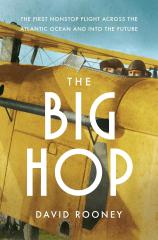The Big Hop: The First Nonstop Flight Across the Atlantic Ocean and Into the Future
Review
The Big Hop: The First Nonstop Flight Across the Atlantic Ocean and Into the Future
On June 14, 1919 --- the day Jack Alcock and Arthur Brown made an undignified near-crash landing in an Irish bog to become the first aviators to cross the Atlantic Ocean in one “hop” --- my British grandmother was preparing to give birth to her first child.
No, that little fact does not appear in David Rooney’s brilliantly woven aeronautical history, THE BIG HOP, but it’s important for all the reasons why an author as diligent and passionate as he would write such a book in the first place. Rooney’s account covers not just the bold headlines and high-profile media of the time, but also those myriad tiny yet crucial details that continue to inform real lives and relationships to this day.
Thirty-one years later, that post-WWI British baby would become my father, a young and ambitious London-based employee of the iconic British Overseas Airways Corporation (BOAC). Back then, passenger flying was held in such esteem that even entry-level travel agents wore uniforms with epaulets and peaked caps that made them look like airplane pilots.
"Thanks to David Rooney’s elegant, passionate and meticulous retelling of what went into that first 'Big Hop,' we can experience in words so much of what it must have been like to be a part of it. THE BIG HOP may be the finest aviation history you ever get to read."
Alcock, Brown and their daring male and female peers (women are centrally mentioned in THE BIG HOP as investors, engineers, designers, builders, instructors and even test pilots) made it all possible. But they likely foresaw little of how aviation would evolve after them. Their groundbreaking efforts nearly became lost to history in the wake of Charles Lindbergh’s successful solo crossing in 1927 with a much more sophisticated plane. To his credit, Lindbergh repeatedly tried to preserve their achievement by mentioning it in interviews.
Where THE BIG HOP stands out significantly from the majority of historical works of this kind is in its deftly balanced attention to multiple backstories that contributed to an achievement that would have enormous ongoing results. Yet one never loses the thread of key events culminating in that first successful flight from the rocky shores of Newfoundland, then an autonomous British colony.
In fact, the book opens at a critical and perilous point over the stormy mid-Atlantic in which Alcock and Brown are fighting to keep their unwieldy Vickers Vimy craft in the air. In their later recollections, both expected imminent death.
With the brave duo literally suspended on the page, Rooney makes an abrupt literary U-turn back to how everything began. It takes immense narrative skill to pull off such a disruption, but he does it as triumphantly as his protagonists managed to complete their journey --- steadily, always focused, and with a few humbling bumps along the way.
Rooney delves into the personal biographies and direct words of not only Alcock and Brown, but dozens of their peers and colleagues. He also weaves into THE BIG HOP some fascinating contextual social and cultural history, economic changes, industrial competition (with a few subtle suggestions of espionage), political movements, the emerging realignment of traditional gender-based career options, the lingering effects of WWI and the Spanish Flu epidemic, and the increasing threat of another major war just over the horizon.
In many respects, these young early 20th-century men and women who first became fascinated by, and then feverishly adept at, the technologies of flight lived in the moment. History gave them an unprecedented explosion of opportunities that cut across class and gender barriers as no movement had ever done before. They worked, played, innovated and even died in relentless pursuit of the seemingly impossible --- long-range flight in heavier-than-air machines. Perhaps the only worthy comparison would be the heady period of the 1960s and ’70s when the Space Race was going full tilt.
Just 35 years after Alcock and Brown’s harrowing, storm-buffeted flight from a makeshift runway in Newfoundland to Galway, Ireland, I made my first flight from Canada to England as a four-year-old. By then, the Big Hop of the 1920s had become the North Atlantic Crescent Route, a series of “hops” that on my trip went from Toronto to Gander (NL), Gander to Prestwick (Scotland), and Prestwick to Gatwick. Instead of a flimsy canvas and wood biplane with its cockpit open to the elements, my flight involved (if memory serves) three different aircraft: a DC-9, a luxurious Stratocruiser (BOAC’s coveted flagship), and a Constellation.
For about another generation after my maiden trip to the UK, flying remained an idealized, romanticized mode of travel in which comfort, service and safety were the hallmarks of a highly respected industry. As Rooney gently laments, this is no longer the case. After my own inaugural flight, I did not travel by air again until long after the glory days of flight as an experience in and of itself were past. There will never be another flight like that first one --- Alcock and Brown’s, or my own.
Thanks to David Rooney’s elegant, passionate and meticulous retelling of what went into that first “Big Hop,” we can experience in words so much of what it must have been like to be a part of it. THE BIG HOP may be the finest aviation history you ever get to read.
Reviewed by Pauline Finch on July 12, 2025
The Big Hop: The First Nonstop Flight Across the Atlantic Ocean and Into the Future
- Publication Date: June 3, 2025
- Genres: History, Nonfiction
- Hardcover: 336 pages
- Publisher: W. W. Norton & Company
- ISBN-10: 1324050969
- ISBN-13: 9781324050964




